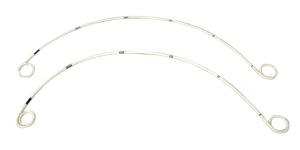Double J Ureteral Stent
The double J ureteral stent set is a medical device used to treat patients with kidney stones or other urinary tract conditions. The stent set consists of two stents, one for each ureter, and is inserted through the patient's urinary tract. The stents are then positioned in the ureters, where they help to keep the ureters open and allow urine to flow freely.
Description
- Radiopaque line throught out catheter facilitating the catheter location.
- Efficient drainage and irrigation.
- Good biocompatibility reducing mucosa stimulating infection.
| Ref. No.: |
Size: |
| NMU201005 |
5 Fr/ch |
| NMU201006 |
6 Fr/ch |
| NMU201007 |
7Fr/ch |
Double J Ureteral Stent Set
The double J ureteral stent set is a medical device used to treat patients with kidney stones or other urinary tract conditions. The stent set consists of two stents, one for each ureter, and is inserted through the patient's urinary tract. The stents are then positioned in the ureters, where they help to keep the ureters open and allow urine to flow freely.
What is a double J ureteral stent?
A double J ureteral stent is a tube that is inserted into the ureter (the tubes that carry urine from the kidneys to the bladder) to help relieve a blockage. The stent is made of a soft, flexible material and has two "J" shaped ends. One end is inserted into the kidney and the other end is inserted into the bladder. The stent stays in place for a period of time and then is removed.
How is a double J ureteral stent placed?
A double J ureteral stent is placed by threading it through the ureter and then attaching it to the kidney. The stent is then left in place for a period of time to allow the kidney to heal.
Pros and cons of a double J ureteral stent
There are a few pros and cons to having a double J ureteral stent. A pro would be that it can help with the drainage of urine from the kidney to the bladder. This can be helpful if you have an obstruction in your urinary tract. A con would be that the stent can sometimes become dislodged and cause pain or discomfort. If this happens, you may need to have the stent removed or replaced.
Alternatives to a double J ureteral stent
There are a few alternatives to a double J ureteral stent that your doctor may recommend. These include:
- A ureteral stent with a larger diameter. This type of stent is less likely to become blocked or dislodged.
- A ureteral stent with a different shape. Some stents are designed to conform better to the anatomy of the urinary tract.
- A ureteral stent made from a different material. Some stents are coated with substances that help prevent infection or blockage.
Double J Ureteral is the strategy to put a slender, adaptable plastic cylinder that is briefly in the ureter to assist pee with depleting from the kidney into the bladder on account of a blockage.
The ureters convey pee from the kidneys to the bladder. (Every kidney is associated with one ureter.) In intriguing cases, the two ureters might be impeded, in which case two-sided ureteral stents are set, one in every ureter.
The stent might stay from days to weeks and even months, contingent upon the circumstance.
Double J Ureteral Stent
The ureters might become obstructed because of various conditions, including:
Kidney stones
Cancers
Blood clumps
Postoperative expanding
Contamination
A ureteral stent may likewise be put during or after urinary parcel a medical procedure to give a shape around which recuperating can happen, to redirect pee from areas of spillage, to control kidney stones or keep stones from moving before therapy, or to make the ureters all the more effectively recognizable during surgeries.
Ureteral impediment might be determined to have a cystoscopy, where a slender cylinder is embedded into the bladder to picture it, ultrasound, registered tomography (CT) filter, or potentially pyelography, where x-beams are taken of the urinary parcel after a difference color has been infused.

Position of the stent is finished utilizing general sedation, so you will probably have to go through an intensive wellbeing screening just as blood tests, chest x-beam, and electrocardiogram (EKG). If it's not too much trouble, keep away from all food and water for 6-8 hours before the system, or as suggested by the specialist. Kindly additionally told your primary care physician pretty much all drug that you are taking as some might should be halted before the technique.
The specialist will embed a cystoscope through the urethra and into the bladder, imagining the opening to the ureter. A slender wire is then directed through the cystoscope, up the ureter, and into the kidney. The stent is embedded over the wire. A fluoroscope, a sort of x-beam machine, might be utilized to situate the stent. The wire and cystoscope are then eliminated.
At the point when the time has come to eliminate the stent, a similar
strategy is utilized. A cystoscope is embedded through the urethra and into the bladder and the stent is gotten a handle on with a little instrument and eliminated. You will be conscious during this strategy and will just require a
nearby sedative.
